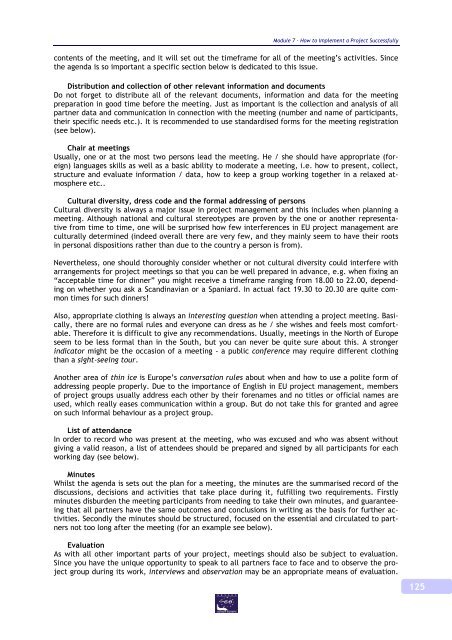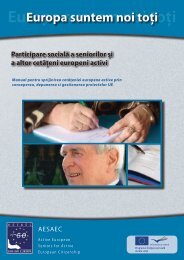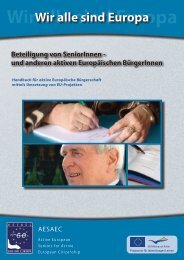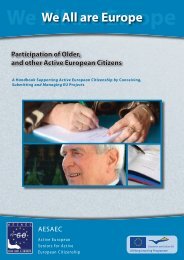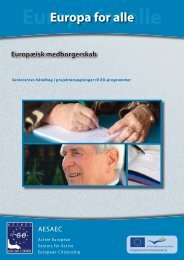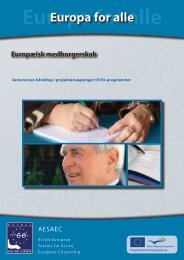We All are Europe - AESAEC
We All are Europe - AESAEC
We All are Europe - AESAEC
You also want an ePaper? Increase the reach of your titles
YUMPU automatically turns print PDFs into web optimized ePapers that Google loves.
Module 7 – How to Implement a Project Successfully<br />
contents of the meeting, and it will set out the timeframe for all of the meeting’s activities. Since<br />
the agenda is so important a specific section below is dedicated to this issue.<br />
Distribution and collection of other relevant information and documents<br />
Do not forget to distribute all of the relevant documents, information and data for the meeting<br />
preparation in good time before the meeting. Just as important is the collection and analysis of all<br />
partner data and communication in connection with the meeting (number and name of participants,<br />
their specific needs etc.). It is recommended to use standardised forms for the meeting registration<br />
(see below).<br />
Chair at meetings<br />
Usually, one or at the most two persons lead the meeting. He / she should have appropriate (foreign)<br />
languages skills as well as a basic ability to moderate a meeting, i.e. how to present, collect,<br />
structure and evaluate information / data, how to keep a group working together in a relaxed atmosphere<br />
etc..<br />
Cultural diversity, dress code and the formal addressing of persons<br />
Cultural diversity is always a major issue in project management and this includes when planning a<br />
meeting. Although national and cultural stereotypes <strong>are</strong> proven by the one or another representative<br />
from time to time, one will be surprised how few interferences in EU project management <strong>are</strong><br />
culturally determined (indeed overall there <strong>are</strong> very few, and they mainly seem to have their roots<br />
in personal dispositions rather than due to the country a person is from).<br />
Nevertheless, one should thoroughly consider whether or not cultural diversity could interfere with<br />
arrangements for project meetings so that you can be well prep<strong>are</strong>d in advance, e.g. when fixing an<br />
“acceptable time for dinner” you might receive a timeframe ranging from 18.00 to 22.00, depending<br />
on whether you ask a Scandinavian or a Spaniard. In actual fact 19.30 to 20.30 <strong>are</strong> quite common<br />
times for such dinners!<br />
Also, appropriate clothing is always an interesting question when attending a project meeting. Basically,<br />
there <strong>are</strong> no formal rules and everyone can dress as he / she wishes and feels most comfortable.<br />
Therefore it is difficult to give any recommendations. Usually, meetings in the North of <strong>Europe</strong><br />
seem to be less formal than in the South, but you can never be quite sure about this. A stronger<br />
indicator might be the occasion of a meeting - a public conference may require different clothing<br />
than a sight-seeing tour.<br />
Another <strong>are</strong>a of thin ice is <strong>Europe</strong>’s conversation rules about when and how to use a polite form of<br />
addressing people properly. Due to the importance of English in EU project management, members<br />
of project groups usually address each other by their forenames and no titles or official names <strong>are</strong><br />
used, which really eases communication within a group. But do not take this for granted and agree<br />
on such informal behaviour as a project group.<br />
List of attendance<br />
In order to record who was present at the meeting, who was excused and who was absent without<br />
giving a valid reason, a list of attendees should be prep<strong>are</strong>d and signed by all participants for each<br />
working day (see below).<br />
Minutes<br />
Whilst the agenda is sets out the plan for a meeting, the minutes <strong>are</strong> the summarised record of the<br />
discussions, decisions and activities that take place during it, fulfilling two requirements. Firstly<br />
minutes disburden the meeting participants from needing to take their own minutes, and guaranteeing<br />
that all partners have the same outcomes and conclusions in writing as the basis for further activities.<br />
Secondly the minutes should be structured, focused on the essential and circulated to partners<br />
not too long after the meeting (for an example see below).<br />
Evaluation<br />
As with all other important parts of your project, meetings should also be subject to evaluation.<br />
Since you have the unique opportunity to speak to all partners face to face and to observe the project<br />
group during its work, interviews and observation may be an appropriate means of evaluation.<br />
125


